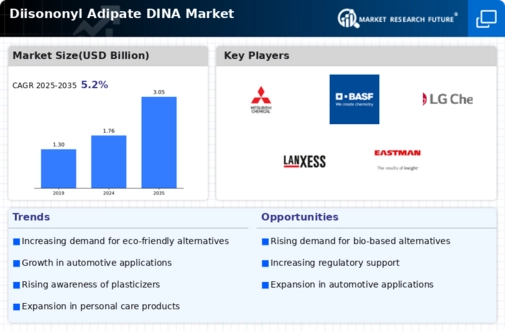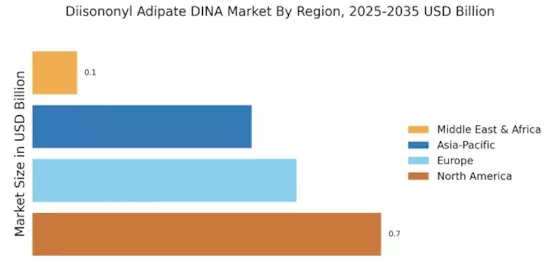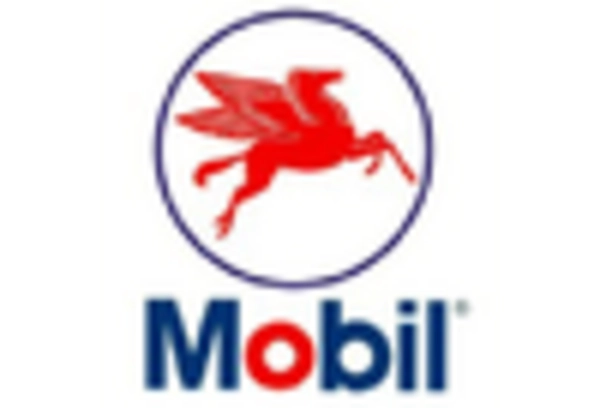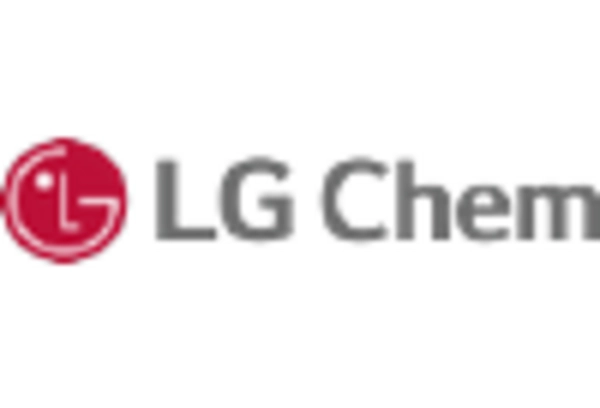Rising Demand for Eco-Friendly Products
The increasing consumer preference for eco-friendly and sustainable products is a pivotal driver in the Diisononyl Adipate DINA Market. As environmental awareness grows, manufacturers are compelled to adopt greener alternatives in their formulations. Diisononyl Adipate, known for its low toxicity and biodegradability, aligns well with this trend. Market data indicates that the demand for sustainable plasticizers, including DINA, is projected to rise significantly, with an estimated growth rate of 5% annually over the next five years. This shift not only enhances brand reputation but also meets regulatory requirements, further solidifying the position of Diisononyl Adipate in the market.
Technological Innovations in Production
Technological advancements in the production processes of Diisononyl Adipate DINA Market are significantly influencing the market landscape. Innovations aimed at improving efficiency and reducing costs are becoming more prevalent. For instance, the adoption of advanced catalytic processes has been shown to enhance yield and purity, making DINA more competitive against alternative plasticizers. Furthermore, these innovations may lead to a reduction in production waste, aligning with sustainability goals. As manufacturers invest in these technologies, the Diisononyl Adipate DINA Market is expected to experience a boost in supply, potentially leading to a decrease in prices and increased accessibility for various applications.
Expanding Applications in Various Industries
The versatility of Diisononyl Adipate DINA Market is a crucial factor driving its market growth. This compound finds applications across multiple sectors, including automotive, construction, and consumer goods. In the automotive industry, for instance, DINA is utilized in the production of flexible PVC, which is essential for interior components. The construction sector also increasingly employs DINA in sealants and adhesives, enhancing product performance. Market analysis suggests that the expansion of these industries will likely propel the demand for Diisononyl Adipate, with a projected increase in consumption by approximately 4% annually. This broad applicability underscores the importance of DINA in the market.
Regulatory Support for Non-Toxic Alternatives
The regulatory environment plays a vital role in shaping the Diisononyl Adipate DINA Market. Governments worldwide are increasingly implementing stringent regulations aimed at phasing out harmful plasticizers, thereby creating a favorable landscape for non-toxic alternatives like DINA. These regulations not only encourage manufacturers to transition to safer options but also enhance consumer confidence in products containing Diisononyl Adipate. Recent data indicates that regions enforcing stricter chemical regulations have seen a marked increase in the adoption of DINA, with a potential market growth of 6% in the next few years. This regulatory support is likely to solidify DINA's position as a preferred choice in various applications.
Increased Focus on Health and Safety Standards
The heightened emphasis on health and safety standards is a significant driver in the Diisononyl Adipate DINA Market. As industries strive to comply with evolving safety regulations, the demand for safer plasticizers is on the rise. Diisononyl Adipate, recognized for its low toxicity profile, is increasingly favored in applications where human exposure is a concern, such as in toys and medical devices. Market trends suggest that the focus on health and safety will continue to grow, potentially leading to a 5% increase in the demand for DINA over the next few years. This focus not only enhances product safety but also aligns with consumer expectations for healthier alternatives.


















Leave a Comment